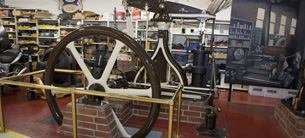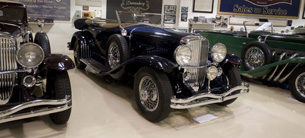Rapid Manufacturing Drives Part Production at Jay Leno’s Garage
Legacy automobiles and motorbikes enjoy long life, thanks to 3D scanning and reverse engineering.
Latest News
March 12, 2009
By Susan Smith
 Designed and built in England in 1832, this steam engine originally ran a dye factory. |
For legacy automotive and other engine parts, using 3D scanning and reverse engineering saves an enormous amount of time and money over traditional methods. Talk show host Jay Leno owns Big Dog garage where he and his team of experts refurbish old automobiles, motorcycles and factory machines such as steam engines. The large collection includes rare and antique motorcycles and cars. The engines he acquires very often have parts that can’t be found anywhere else, so that when they break, a custom part needs to be made.
In the past, the legacy parts were measured with calipers, but with today’s technology, antique auto enthusiasts can scan the parts, and then reverse engineer them to create a parametric solid file. From there parts can be machined in a CNC machine or recreated for fit and function in a 3D printer.
“We used to send our parts to India to get them made,” said Leno.
The use of NextEngine 3D scanning and reverse engineering software have made a huge difference in the recreation of these one-off parts, according to Dan Gustafson, marketing director for NextEngine. Big Dog Garage owns their own 3D scanning and rapid prototyping equipment, so they can quickly recreate one-of-a-kind parts within a garage environment. “Typically these parts were so expensive they would have someone else do it for them, and they would have a couple of them made so if they broke in the future, they had extra ones. Now if they want to go back and recreate it later, they can pull up a digital file and recreate the part. They can also do a fit and function test on a 3D printer before they machine their part.”
 The 2009 Mini E is 100% electric with regenerative braking and zero emissions. |
NextEngine has a comprehensive set of tools to generate whatever kind of file the user wants to create, whether it’s a mesh file, a NURBs surface file or parametric file for creating digital models. The scanner comes with software that allows the user to scan an object to create a watertight mesh file with software that has a number of different file formats.
NURBs surface files can be created that can be saved as either an IGES or STEP file which are typically used for machining or taking design intent into another CAD system. A user can take an organic shape, capture and infuse it into his or her design workflow to facilitate the modeling process, using the NextEngine software package called ScanStudio CAD tools for NURBS surface creation.
Another tool the company sells is Rapidworks for creating a parametric solid file, priced at $2500. NextEngine partners with Rapidform to offer their XOR product which sells for $20,000 to NextEngine users which has the power of the $20,000 system. The catch is that Rapidworks only works with NextEngine’s scan data and scanners.
 1930 Duesenberg LeBaron Barrelside |
Gustafson said that Rapidworks “allows you to generate a parametric solid file with a feature tree that allows you to have parent child relationships in that solid file. If you wanted to modify specific parameters of that file you could do that. You can save it out to a SolidWorks file and edit however you want, and it maintains the parent/child relationship within the parametric structure.” Rapidworks was used with the scanner in the Big Dog Garage.
The full solution costs approximately $5500 to scan and to be able to reverse engineering a part to a parametric solid file. For the scanner and software: $2995. For reverse engineering, add on $2500.
The scanner is said to be accurate to within five thousands of an inch. “What we’re able to do is scan the object at that accuracy, then put it into Rapidworks within that program,” explained Gustafson. “If you have close tolerances you can define those exact tolerances within Rapidworks, then you’re only limited to the accuracy of your manufacturing process. It gives you the capability of having extreme control over the dimensioning of your part. If you’re doing an artistic part, you’re creating a mesh file, and machining off the mesh file, then your accuracy of your reproduction would be the accuracy of the scanner plus the accuracy of your machining process.”
Leno said the technology allows his garage to make any parts they need, adding, “You can keep old cars on the road forever now.”
NextEngine
Santa Monica,CA
INUS Technology, Inc.
Seoul, South Korea
Susan Smith is a contributing editor for Desktop Engineering magazine. She has been an editor and writer for the technology industry for more than 15 years and resides in Santa Fe, NM. Send e-mail about this article to [email protected].
Subscribe to our FREE magazine, FREE email newsletters or both!
Latest News
About the Author
DE’s editors contribute news and new product announcements to Digital Engineering.
Press releases may be sent to them via [email protected].






